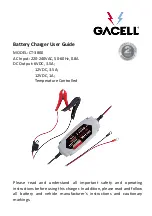
1. DC Battery
HOW TO USE
DEEP CYCLE BATTERY MAINTENANCE
04
•
Start your vehicle and let it idle.
•
The battery cable should be connected first, otherwise it cannot be charged.
•
And the charger will recognize that there is a charge being applied to the main
starting battery.
•
The charger will charge the auxiliary battery when the main starting battery has
reached 12.5V.
•
Long press "POWER" to re-select batteries (The default setting is for lead acid battery,
and your setting will be saved once selection is made).The charger will continue to
operate even after the vehicle has been switched off ,however when the main starting
battery below 12.5V will derate charging ;below 12V, the charging will automatically
shut off.
2. Solar Input
•
The charger will shift to solar charge mode when the input terminal is connected to
the solar panel.
•
Long press "POWER" to select the corresponding battery type, and batteries can be
re-selected during charging by long pressing the button.
•
Charging begins when the output of the solar panel reaches 16V~25V, and the panel
will stop the charge when its output is below 10V.
Note: this charger is not designed to charge your auxiliary battery with DC inputs and solar
concurrently, DC enjoys input priority over solar.
•
This DC-DC charger will be used to charge your auxiliary battery, for example, deep
cycle batteries that are designed to provide power for your fridges and lights in your
caravan or camper.
•
It is known that the lifespan of a deep cycle battery can be extended if it is not
discharged below 50% of its full capacity. A fully charged battery (50 amp) can deliver
50 amp/hours without shortening its lifespan.
•
Your fridge might use appropriately 24 amps per day. If your 100AH battery is only
used to power your fridge while receiving no charge, it would require charging after
48 hours.




























